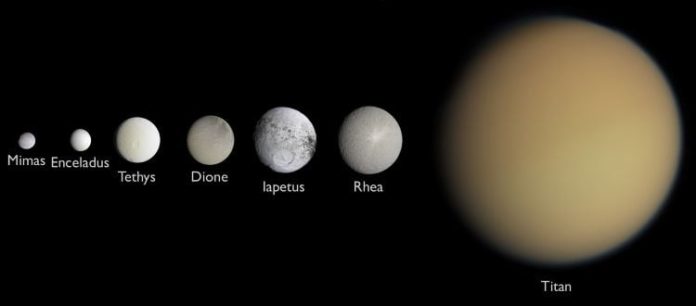
What can carbon dioxide (CO₂) on Saturn’s moons teach scientists about their formation and evolution?
This is what a recent study submitted to The Planetary Science Journal hopes to address as a team of researchers investigated the different types of CO₂ that exist on several of Saturn’s mid-sized moons.
This study has the potential to help scientists better understand the existence of CO₂ on planetary bodies and what this could mean for their formation and evolution, and potentially whether they could possess life as we know it.
For the study, the researchers used data obtained from NASA’s powerful James Webb Space Telescope (JWST) to observe and analyze the presence of CO₂ on eight of Saturn’s mid-sized moons, including (in alphabetical order) Dione, Enceladus, Hyperion, Iapetus, Mimas, Phoebe, Rhea, and Tethys.
The goal of the study was to ascertain the types of CO₂ on each moon through the wavelength shifts in JWST’s data.
In the end, the researchers identified four types of trapped CO₂ on the moons, with CO₂ on Dione and Rhea being supplied from Saturn’s E-ring. Moving outward, the researchers concluded that CO₂ is produced from organics on Phoebe, which then transfers to the dark regions of Iapetus and Hyperion.
Finally, the researchers discovered trapped CO₂ within water ice on Iapetus and Hyperion. To complement these intriguing findings, the researchers note how they could extend to the Galilean moons of Jupiter.
The study notes, “These observations have interesting implications for the icy Galilean satellites and the state of their CO₂ as well.
Interpretations for the CO₂ detected on the Galilean satellites are sometimes similar to the interpretations we have made here for the Saturnian satellites, though in some cases the similarity of the interpretation is in spite of large spectral differences.”
This study comes after scientists used JWST data to identify carbon on Europa in 2023 which followed a Hubble Space Telescope study that found carbon on Europa in 2019. Beyond the solar system, JWST has observed CO₂ on several gas giant exoplanets within the HR 8799 system earlier this year.
While CO₂ only comprises approximately 0.04 percent of Earth’s atmosphere, it plays a crucial role in regulating the planet’s temperature and plant life, as plant’s use photosynthesis to convert CO₂ to oxygen. Beyond Earth and in our solar system, CO₂ is found in abundance on Venus and Mars, with CO₂ contributing to the former’s runaway greenhouse effect and both planets are estimated to have approximately 96 percent CO₂ in their respective atmospheres.
While CO₂ is not considered a definitive biosignature, scientists can use its presence to indicate the possibility of biological activity while providing scientists greater insight into a planetary body’s habitability, whether in its atmosphere or on its surface. Despite the moons analyzed for this study are all airless bodies, the presence of CO₂ could provide clues into each of their histories, specifically their formation and evolution and how Saturn’s rings play a role in that, as well.
Going forward, the researchers call for additional research to be conducted on the dark material observed on several of Saturn’s moons, along with laboratory experiments that could shed light on the processes responsible for trapping CO₂.
What new discoveries about Saturn’s moons and CO₂ will researchers make in the coming years and decades? Only time will tell, and this is why we science!
As always, keep doing science & keep looking up!
Written by Laurence Tognetti/Universe Today.



